The cultivation of reserve sows is becoming increasingly meticulous in modern pig farms. With the vigorous promotion of scientific research on reserve sows, more parameters and indicators related to production performance will be proposed in the process of cultivating reserve sows, and breakthrough progress will be made in pig farm management.
As for the current research and practical experience summary of reserve sows, there are many studies on the six parameters of age at first mating, mating weight, backfat thickness at mating, number of estrus cycles, age at first mating, and aphrodisiac feeding. Especially, the backfat thickness measured by ultrasound during first mating is an important parameter for reserve sows and has a significant impact on their production performance. How to control the backfat thickness of reserve sows and the above six breeding parameters has become a problem faced by reserve sow breeders.
The effect of backfat thickness on the production performance of reserve sows during breeding. Large white sows with moderate backfat condition (backfat thickness 15.5-20 mm) before breeding have the highest number of live piglets. Therefore, it is more scientific to use pigs to measure the backfat thickness of reserve sows using ultrasound and then determine the breeding time. When the backfat thickness is between 15.5-20 mm, the newborn litter weight is also the heaviest, and during lactation, no or less backfat loss can shorten the interval from weaning to estrus, increase the number of live piglets born in the next litter, and improve the newborn litter weight of piglets.








